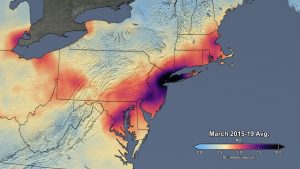
 Over the last several weeks, NASA satellite measurements have revealed significant reductions in air pollution over the major metropolitan areas of the Northeast United States. Similar reductions have been observed in other regions of the world. These recent improvements in air quality have come at a high cost, as communities grapple with widespread lockdowns and shelter-in-place orders as a result of the spread of COVID-19.
Over the last several weeks, NASA satellite measurements have revealed significant reductions in air pollution over the major metropolitan areas of the Northeast United States. Similar reductions have been observed in other regions of the world. These recent improvements in air quality have come at a high cost, as communities grapple with widespread lockdowns and shelter-in-place orders as a result of the spread of COVID-19.
Nitrogen dioxide, primarily emitted from burning fossil fuels for transportation and electricity generation, can be used as an indicator of changes in human activity. These images show average concentrations of atmospheric nitrogen dioxide as measured by the Ozone Monitoring Instrument (OMI) on NASA's Aura satellite, as processed by a team at NASA's Goddard Space Flight Center, Greenbelt, Md. The left image shows the average concentration in March of 2015-19, while the right image shows the average concentration measured in March 2020.
Though variations in weather from year to year cause variations in the monthly means for individual years, March 2020 shows the lowest monthly atmospheric nitrogen dioxide levels of any March during the OMI data record, which spans 2005 to the present. In fact, the data indicate that the nitrogen dioxide levels in March 2020 are about 30 percent lower on average across the region of the I-95 corridor from Washington, D.C., to Boston than when compared to the March mean of 2015-19. Further analysis will be required to rigorously quantify the amount of the change in nitrogen dioxide levels associated with changes in emissions versus natural variations in weather.
Image Credit: NASA

